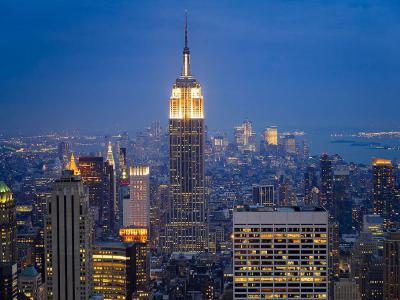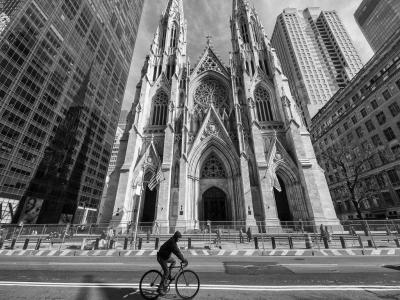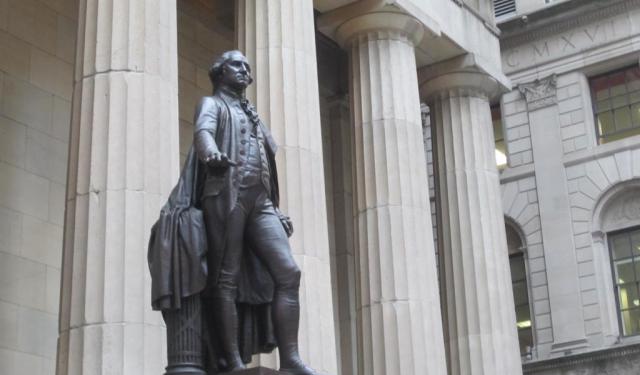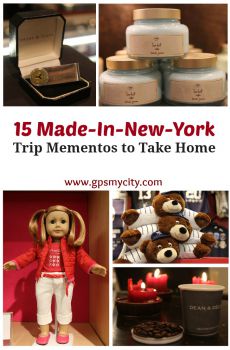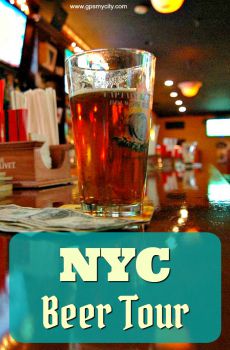
Manhattan Architecture Walking Tour (Self Guided), New York
The skyscraper, which has shaped Manhattan's distinctive skyline, has been closely associated with New York City’s identity since the end of the 19th century. Despite the Great Depression, some of the world’s tallest skyscrapers were completed in Manhattan during the 1930s, including numerous Art Deco masterpieces that are still part of the city's skyline – most notably the Empire State Building, the Chrysler Building and the 30 Rockefeller Plaza that forms the centerpiece of Rockefeller Center. Even now that other commercial structures have reached far greater heights, they remain icons that refuse to relinquish their special meaning.
As you will also see on this special tour, however, Manhattan’s intricate architecture is not represented only by the huge number of tall buildings. Proper handling of the large-scale planning and technical aspects allowed the Grand Central Terminal complex to be seen easily from below. And now, even with high-rise buildings around, it stands as a solid and radiating icon of innovative urban design. The station’s main facade, a Roman triumphal arch, symbolizes the gateway to the city.
Not far from the Empire State Building, Macy’s original flagship store is 9 stories above ground and covers an entire block. A department store in the GRANDEST tradition, it oozes with history from an architectural standpoint. Make sure you see the old wooden escalators on the Broadway side!
Yet another unique and majestic sight, the Flatiron Building stands at Broadway and Fifth Avenue – the two most important streets of NYC. Although you cannot visit inside, the main attraction is outside where the wedge shape captivates tourists flocking around the park opposite taking photo after photo. Besides its subtle elegance, the building has an interesting backstory, too. Due to the wind-tunnel effect at the site, in the early 20th century, men would hang out on the corner and watch the wind blowing women’s dresses up so that they could catch a little bit of ankle. This entered into popular culture and there are hundreds of postcards and illustrations of women with their dresses blowing up in front of the Flatiron Building.
Follow our self-guided walking tour to visit some of the most famous architectures in Midtown Manhattan at your own pace.
As you will also see on this special tour, however, Manhattan’s intricate architecture is not represented only by the huge number of tall buildings. Proper handling of the large-scale planning and technical aspects allowed the Grand Central Terminal complex to be seen easily from below. And now, even with high-rise buildings around, it stands as a solid and radiating icon of innovative urban design. The station’s main facade, a Roman triumphal arch, symbolizes the gateway to the city.
Not far from the Empire State Building, Macy’s original flagship store is 9 stories above ground and covers an entire block. A department store in the GRANDEST tradition, it oozes with history from an architectural standpoint. Make sure you see the old wooden escalators on the Broadway side!
Yet another unique and majestic sight, the Flatiron Building stands at Broadway and Fifth Avenue – the two most important streets of NYC. Although you cannot visit inside, the main attraction is outside where the wedge shape captivates tourists flocking around the park opposite taking photo after photo. Besides its subtle elegance, the building has an interesting backstory, too. Due to the wind-tunnel effect at the site, in the early 20th century, men would hang out on the corner and watch the wind blowing women’s dresses up so that they could catch a little bit of ankle. This entered into popular culture and there are hundreds of postcards and illustrations of women with their dresses blowing up in front of the Flatiron Building.
Follow our self-guided walking tour to visit some of the most famous architectures in Midtown Manhattan at your own pace.
How it works: Download the app "GPSmyCity: Walks in 1K+ Cities" from Apple App Store or Google Play Store to your mobile phone or tablet. The app turns your mobile device into a personal tour guide and its built-in GPS navigation functions guide you from one tour stop to next. The app works offline, so no data plan is needed when traveling abroad.
Manhattan Architecture Walking Tour Map
Guide Name: Manhattan Architecture Walking Tour
Guide Location: USA » New York (See other walking tours in New York)
Guide Type: Self-guided Walking Tour (Sightseeing)
# of Attractions: 8
Tour Duration: 2 Hour(s)
Travel Distance: 4.2 Km or 2.6 Miles
Author: doris
Sight(s) Featured in This Guide:
Guide Location: USA » New York (See other walking tours in New York)
Guide Type: Self-guided Walking Tour (Sightseeing)
# of Attractions: 8
Tour Duration: 2 Hour(s)
Travel Distance: 4.2 Km or 2.6 Miles
Author: doris
Sight(s) Featured in This Guide:
- Rockefeller Center
- St. Patrick's Cathedral
- Grand Central Terminal
- Chrysler Building
- New York Public Library
- Empire State Building
- Macy's in Herald Square
- Flatiron Building
1) Rockefeller Center (must see)
In 1801, New York physician David Hosack bought 22 acres of open land from the city with an aim to establish the country's first botanical garden, the Elgin Botanic Garden. The latter had lasted only until 1811, for the lack of funds, following which the territory was taken over by Columbia University, in 1823.
In 1926, the property changed hands again when the Metropolitan Opera sought location for its new home; so the University leased the land to the theater's benefactor, John D. Rockefeller, Jr. After the stock market crashed, in 1929, the Met Opera move was canceled, and Rockefeller decided to build a mass media complex instead.
The ensued talks between Radio Corporation of America, National Broadcasting Company, and Radio-Keith-Orpheum Radio resulted in an agreement, in 1930, to build on the site an entertainment complex. Pursuant to this agreement, 228 buildings were demolished and 4,000 tenants relocated. Early on, the project was called "Radio City," "Rockefeller City," or "Metropolitan Square."
Presently, Rockefeller Center represents a compound of two complexes (comprising 14 Art Deco-style buildings), one solitary edifice on 51st Street (added in 1947), and four towers on the west side of Sixth Avenue. The venue covers all of Doctor Hosack's 22 acres, and, whilst there's no botanicals on the ground, it does have some rooftop gardens.
Radio City Music Hall occupies the western part of the Center. The Lower Plaza, at the heart of the complex, lends a sense of privacy, being sunken below street level. Architect Ieoh Ming Pei praised it as "the most successful open space in the United States, perhaps in the world." Most of the Plaza's outdoor area is taken up by an ice rink, installed in 1936.
In addition to the spectacular, unobstructed views of the NYC skyline opening from the top of the Rock’s three levels of indoor and outdoor observation decks, the Center offers a shopping experience like no other. The abundant choice of popular local brands, international names, and up-and-coming designers makes it one of the best shopping destinations in Midtown Manhattan. This is where you come to realize that shopping is as much about the place as it is about what you buy.
In 1926, the property changed hands again when the Metropolitan Opera sought location for its new home; so the University leased the land to the theater's benefactor, John D. Rockefeller, Jr. After the stock market crashed, in 1929, the Met Opera move was canceled, and Rockefeller decided to build a mass media complex instead.
The ensued talks between Radio Corporation of America, National Broadcasting Company, and Radio-Keith-Orpheum Radio resulted in an agreement, in 1930, to build on the site an entertainment complex. Pursuant to this agreement, 228 buildings were demolished and 4,000 tenants relocated. Early on, the project was called "Radio City," "Rockefeller City," or "Metropolitan Square."
Presently, Rockefeller Center represents a compound of two complexes (comprising 14 Art Deco-style buildings), one solitary edifice on 51st Street (added in 1947), and four towers on the west side of Sixth Avenue. The venue covers all of Doctor Hosack's 22 acres, and, whilst there's no botanicals on the ground, it does have some rooftop gardens.
Radio City Music Hall occupies the western part of the Center. The Lower Plaza, at the heart of the complex, lends a sense of privacy, being sunken below street level. Architect Ieoh Ming Pei praised it as "the most successful open space in the United States, perhaps in the world." Most of the Plaza's outdoor area is taken up by an ice rink, installed in 1936.
In addition to the spectacular, unobstructed views of the NYC skyline opening from the top of the Rock’s three levels of indoor and outdoor observation decks, the Center offers a shopping experience like no other. The abundant choice of popular local brands, international names, and up-and-coming designers makes it one of the best shopping destinations in Midtown Manhattan. This is where you come to realize that shopping is as much about the place as it is about what you buy.
2) St. Patrick's Cathedral (must see)
There are two St. Patrick's Cathedrals in New York City. The construction of New St. Patrick's Cathedral was started in 1858 to accommodate the growing Archdiocese of New York and to replace St. Patrick's Old Cathedral, built in 1815. New St. Patrick's is the enormous Gothic Revival edifice erected between 50th and 51st Streets on Madison Avenue in Manhattan. It is the seat of the Archbishop of New York. Located directly across from Rockefeller Center, it was designed by architect James Renwick, Jr., and inaugurated in 1879.
The Midtown Cathedral is triumphantly vertical and Gothic. It is clad in marble. It has dozens of stained glass windows encased in pointed arches topped by triangular pediments. It is 332 feet long and the transepts are 174 feet wide. Soaring spires flank the enormous bronze entrance doors. The spires reach a height of 330 feet.
Inside is a nave with a center aisle and two side aisles. Thirty-two marble columns separate the center and side aisles. Above the center aisle are groin vaults supported by ribs and bosses. There are 12 chapels in the side aisles. The interior is designed for a seating capacity of 2,400. There are 300 wooden pews.
The high altar is a replacement. The original was moved to Fordham University Church in the Bronx. The current altar is made of grey-white Italian marble covered with a bronze canopy or baldachin. There is no tabernacle or altar screen. The baldachin is topped by a statue of Christ the King flanked by angels and pinnacles.
The New St. Patrick's Cathedral is a New York City designated landmark and is listed on the National Register of Historic Places.
The Midtown Cathedral is triumphantly vertical and Gothic. It is clad in marble. It has dozens of stained glass windows encased in pointed arches topped by triangular pediments. It is 332 feet long and the transepts are 174 feet wide. Soaring spires flank the enormous bronze entrance doors. The spires reach a height of 330 feet.
Inside is a nave with a center aisle and two side aisles. Thirty-two marble columns separate the center and side aisles. Above the center aisle are groin vaults supported by ribs and bosses. There are 12 chapels in the side aisles. The interior is designed for a seating capacity of 2,400. There are 300 wooden pews.
The high altar is a replacement. The original was moved to Fordham University Church in the Bronx. The current altar is made of grey-white Italian marble covered with a bronze canopy or baldachin. There is no tabernacle or altar screen. The baldachin is topped by a statue of Christ the King flanked by angels and pinnacles.
The New St. Patrick's Cathedral is a New York City designated landmark and is listed on the National Register of Historic Places.
3) Grand Central Terminal (must see)
The terms Grand Central Terminal and Grand Central Station are used interchangeably, but the station is also the central post office joined at the hip to the rail terminal. The business magnate Cornelius Vanderbilt bought the Hudson River and New York Central railroads in 1867. He merged them and started work on Grand Central Depot in 1869.
Architect John B. Snook designed the Grand Central Depot in the Second Empire style. The depot, with all its improvements, was completed by 1874. Trains approaching from the north would descend into the Park Avenue Tunnel at 96th street and travel underground to the terminal. This was a much safer deal than rattling down the crowded streets.
In 1902, a southbound steam locomotive ran past signals in the smoke-filled Park Avenue Tunnel and crashed into another train. After this accident, the depot was torn down and replaced by the current Grand Central Terminal. The architectural firm of Reed and Stern was responsible for the overall design of the station, while Warren and Wetmore worked on the Beaux-Arts exterior.
Grand Central Terminal features permanent works of art, including the celestial ceiling in the Main Concourse, the Glory of Commerce work, the statue of Cornelius Vanderbilt in front of the building's south facade, and the two cast-iron eagle statues adorning the terminal's facades.
Exhibitions and events are held regularly in Vanderbilt Hall. The Dining Concourse has exhibits of lightboxes. The terminal is also known for its performance and installation art, including flash mobs and other spontaneous events.
Architect John B. Snook designed the Grand Central Depot in the Second Empire style. The depot, with all its improvements, was completed by 1874. Trains approaching from the north would descend into the Park Avenue Tunnel at 96th street and travel underground to the terminal. This was a much safer deal than rattling down the crowded streets.
In 1902, a southbound steam locomotive ran past signals in the smoke-filled Park Avenue Tunnel and crashed into another train. After this accident, the depot was torn down and replaced by the current Grand Central Terminal. The architectural firm of Reed and Stern was responsible for the overall design of the station, while Warren and Wetmore worked on the Beaux-Arts exterior.
Grand Central Terminal features permanent works of art, including the celestial ceiling in the Main Concourse, the Glory of Commerce work, the statue of Cornelius Vanderbilt in front of the building's south facade, and the two cast-iron eagle statues adorning the terminal's facades.
Exhibitions and events are held regularly in Vanderbilt Hall. The Dining Concourse has exhibits of lightboxes. The terminal is also known for its performance and installation art, including flash mobs and other spontaneous events.
4) Chrysler Building
For almost a year (11 months) prior to the completion of the Empire State Building, the Chrysler Building enjoyed the status of the world's tallest skyscraper. It was erected at an enormous rate of four floors a week, but despite the haste, no incident or accident occurred during the construction.
Commissioned by the automobile magnate Walter P. Chrysler, the skyscraper was designed by architect William Van Alen in 1928, and was meant to house the headquarters of the Chrysler company – hence the ornamentation in the lower floors, featuring steel automobile parts. Regarded by many well-known contemporary architects as the most beautiful structure in New York City, the building features art deco style with gradually decreasing steel arches studded with triangular windows. At 319 meters high and with 77 floors topped by a 38-meter spire, this is the highest steel-supported brick structure in the world. Initially, there was a viewing gallery on the 71st floor which was then closed in 1945. The marble-clad lobby has a mural in the ceiling, showing an automobile assembly line.
The Chrysler Building remains New York's best-loved skyscraper and was ranked 9th in the survey of the Favorite Architectural Memories in the US, ahead of many well-known landmarks, like the now destroyed World Trade Center. In 1976, the Chrysler Building was declared a National Historic Landmark.
Why You Should Visit:
Art-deco icon that looks good from any vantage point, but well worth a detour to take a closer look.
Tip:
If time is in shortage, just walk into the lobby to see the beautiful walls and floor. The ceiling is a unique work of art.
Commissioned by the automobile magnate Walter P. Chrysler, the skyscraper was designed by architect William Van Alen in 1928, and was meant to house the headquarters of the Chrysler company – hence the ornamentation in the lower floors, featuring steel automobile parts. Regarded by many well-known contemporary architects as the most beautiful structure in New York City, the building features art deco style with gradually decreasing steel arches studded with triangular windows. At 319 meters high and with 77 floors topped by a 38-meter spire, this is the highest steel-supported brick structure in the world. Initially, there was a viewing gallery on the 71st floor which was then closed in 1945. The marble-clad lobby has a mural in the ceiling, showing an automobile assembly line.
The Chrysler Building remains New York's best-loved skyscraper and was ranked 9th in the survey of the Favorite Architectural Memories in the US, ahead of many well-known landmarks, like the now destroyed World Trade Center. In 1976, the Chrysler Building was declared a National Historic Landmark.
Why You Should Visit:
Art-deco icon that looks good from any vantage point, but well worth a detour to take a closer look.
Tip:
If time is in shortage, just walk into the lobby to see the beautiful walls and floor. The ceiling is a unique work of art.
Sight description based on Wikipedia.
5) New York Public Library (must see)
Also known as the Stephan A. Schwartzman Building, the Main Branch of 42nd Street Library is an embodiment of the New York Public Library system. It is located on Fifth Avenue between 40th and 42nd Streets. It shares the block with Bryant Park. The structure is a Beaux-Arts gem of a building.
The Astor and Lenox Libraries were merged in 1895. An imposing main branch was needed to house the newly formed New York Public Library. The perfect site for the new building was under the old obsolete Croton Distributing Reservoir. The architectural firm of Carrere and Hastings was selected to design and build the new library.
On May 24, 1911, the library opened to the public. The first volume borrowed from the library's collection was "Ethical Ideas of Our Time: a study of Nietzsche and Lev Tolstoy" by Russian philosopher and writer Nikolai Grot. During the first week of its operation, the library received 250,000 visitors and patrons.
The exterior of the library building is of Vermont marble and brick. Windows, doors, and fixtures are bronze. Pediments installed above the central entrance hold sculptures of "Life," "Painting," and "Sculpture." A balcony wraps the Fifth Avenue elevation.
At the main entrance, a grand staircase leads to a portico with six Corinthian columns and three archways. Two lions of Tennessee marble guard the staircase on either side.
The Astor and Lenox Libraries were merged in 1895. An imposing main branch was needed to house the newly formed New York Public Library. The perfect site for the new building was under the old obsolete Croton Distributing Reservoir. The architectural firm of Carrere and Hastings was selected to design and build the new library.
On May 24, 1911, the library opened to the public. The first volume borrowed from the library's collection was "Ethical Ideas of Our Time: a study of Nietzsche and Lev Tolstoy" by Russian philosopher and writer Nikolai Grot. During the first week of its operation, the library received 250,000 visitors and patrons.
The exterior of the library building is of Vermont marble and brick. Windows, doors, and fixtures are bronze. Pediments installed above the central entrance hold sculptures of "Life," "Painting," and "Sculpture." A balcony wraps the Fifth Avenue elevation.
At the main entrance, a grand staircase leads to a portico with six Corinthian columns and three archways. Two lions of Tennessee marble guard the staircase on either side.
6) Empire State Building (must see)
The king of Art Deco skyscrapers, the 102-story Empire State Building soars to 1,454 feet above the sidewalks of Manhattan. Once the tallest building in the world, it is now the seventh-tallest in New York, ninth in the USA, and 54th in the world. It is still the sixth-tallest freestanding edifice in the Americas.
The name "Empire State" is the nickname of the State of New York. The design of the building was created by the architectural firm Shrive, Lamb & Harmon. Construction started in 1930 and finished in 1931. The skyscraper stands on the site of the old Waldorf-Astoria Hotel, built in 1893. The builders of the Empire State determined it should be the highest in the world.
The Empire State sits in Midtown South on the west side of Fifth Avenue between 34th and 35th Streets. The 80th, 86th, and 102nd floors have observatories with a commanding 360-degree view of just about everything. The Empire State Building is a cultural icon. It has been featured in more than 250 television series and films since the film King Kong was broadcast in 1933.
The facade is made of Indiana limestone and granite. The decorations on the exterior are mainly geometric, without narrative. The metal doors of the main entrance are flanked by molded piers topped with streamlined eagles and a transom with the golden letters of its name.
The Empire State Building was designated a city landmark by the New York City landmarks Preservation Commission in 1980 and was added to the list of National Historic Landmarks in 1986.
The name "Empire State" is the nickname of the State of New York. The design of the building was created by the architectural firm Shrive, Lamb & Harmon. Construction started in 1930 and finished in 1931. The skyscraper stands on the site of the old Waldorf-Astoria Hotel, built in 1893. The builders of the Empire State determined it should be the highest in the world.
The Empire State sits in Midtown South on the west side of Fifth Avenue between 34th and 35th Streets. The 80th, 86th, and 102nd floors have observatories with a commanding 360-degree view of just about everything. The Empire State Building is a cultural icon. It has been featured in more than 250 television series and films since the film King Kong was broadcast in 1933.
The facade is made of Indiana limestone and granite. The decorations on the exterior are mainly geometric, without narrative. The metal doors of the main entrance are flanked by molded piers topped with streamlined eagles and a transom with the golden letters of its name.
The Empire State Building was designated a city landmark by the New York City landmarks Preservation Commission in 1980 and was added to the list of National Historic Landmarks in 1986.
7) Macy's in Herald Square
Since its opening in 1902, the legendary Macy's flagship store in Herald Square has been a shopping paradise for visitors and an architectural icon and landmark of New York City. A store like no other, it has continued to be a trendsetter from its inception and was the first building to have a modern-day escalator. With 1,250,000 square feet of retail space under one roof, Macy's is one of the largest department stores in the United States. It was added to the list of National Historic Landmarks in 1978.
The store covers an entire city block with 11 levels of the latest fashions, featuring a dazzling array of designer brands, choices, and quality which never fail to amaze. Restaurants and cafes can be found throughout the store, and exciting events are held here almost every day.
The place is also famous for its elaborate animated holiday and Christmas window displays. Each year presents a different theme shown in six windows on the Broadway side of the building.
Macy's is known for its great sales, especially compared to other major New York City department stores. If you crave some refreshment or feel like having a bite, there are plenty of dining options to consider, from casual, fast-food eateries to the more refined sit-down restaurants, so there's no reason for you to go hungry or thirsty while shopping at Macy's.
The store covers an entire city block with 11 levels of the latest fashions, featuring a dazzling array of designer brands, choices, and quality which never fail to amaze. Restaurants and cafes can be found throughout the store, and exciting events are held here almost every day.
The place is also famous for its elaborate animated holiday and Christmas window displays. Each year presents a different theme shown in six windows on the Broadway side of the building.
Macy's is known for its great sales, especially compared to other major New York City department stores. If you crave some refreshment or feel like having a bite, there are plenty of dining options to consider, from casual, fast-food eateries to the more refined sit-down restaurants, so there's no reason for you to go hungry or thirsty while shopping at Macy's.
8) Flatiron Building
Perhaps the most photographed edifice in New York City, the Flatiron Building owes its popularity and name to the unique design. The isosceles triangle-shaped building may not be as high as the nearby high risers of today, but when it opened its doors for the first time in 1901, it surely was one of the tallest in New York – 307 feet, 21 floors – rising like a Greek column, contrary to the other New York skyscrapers rising from a lower base block.
The Flatiron building was designed by Chicago architect, Daniel Burnham, as an office building for the Fuller Construction Company. Styled renaissance palazzo with beaux art detailing, it has the exterior of steel clad with terra cotta. Upon inauguration, the building was dubbed Burnham’s Folly by skeptics who doubted it would stand against strong winds. The design, however, has defied their misgivings and remained structurally sound till the present. Nowadays, it houses the headquarters of the McMillan Publishing Company.
The Flatiron building symbolizes New York City in picture postcards, television commercials and documentaries. It became a New York City landmark in 1966 and was added to the National Register of Historic Places in 1976.
Why You Should Visit:
The exterior of the structure is certainly unique and well worth a photo!
Tip:
At the crossroads between 5th Avenue and Broadway, this should be not the only attraction in the area. The district is trendy, and you can sit outside at one of the many local cafes or in Madison Square Park and just watch people go about their lives all day long. Alternatively, if you're more creatively inclined, the area has plenty of stores catering to those loving artistic design, as well as hip cafes and restaurants.
The Flatiron building was designed by Chicago architect, Daniel Burnham, as an office building for the Fuller Construction Company. Styled renaissance palazzo with beaux art detailing, it has the exterior of steel clad with terra cotta. Upon inauguration, the building was dubbed Burnham’s Folly by skeptics who doubted it would stand against strong winds. The design, however, has defied their misgivings and remained structurally sound till the present. Nowadays, it houses the headquarters of the McMillan Publishing Company.
The Flatiron building symbolizes New York City in picture postcards, television commercials and documentaries. It became a New York City landmark in 1966 and was added to the National Register of Historic Places in 1976.
Why You Should Visit:
The exterior of the structure is certainly unique and well worth a photo!
Tip:
At the crossroads between 5th Avenue and Broadway, this should be not the only attraction in the area. The district is trendy, and you can sit outside at one of the many local cafes or in Madison Square Park and just watch people go about their lives all day long. Alternatively, if you're more creatively inclined, the area has plenty of stores catering to those loving artistic design, as well as hip cafes and restaurants.
Walking Tours in New York, New York
Create Your Own Walk in New York
Creating your own self-guided walk in New York is easy and fun. Choose the city attractions that you want to see and a walk route map will be created just for you. You can even set your hotel as the start point of the walk.
New York's Central Park Walking Tour
Arguably the most famous public park in the world today, Central Park has been called the lungs of New York City – literally “central”, it is where Manhattanites go to get a sense of space and air. Plan for at least half a day to wander along its many pathways, take a rowboat on the water, enjoy the landscaping and the numerous man-made wonders, spend some time at the zoo or bring a pair of... view more
Tour Duration: 3 Hour(s)
Travel Distance: 4.6 Km or 2.9 Miles
Tour Duration: 3 Hour(s)
Travel Distance: 4.6 Km or 2.9 Miles
Midtown Manhattan Shopping Tour
Midtown Manhattan, alongside other things, is also the shopping hub for New York City. Attesting to this are the ever-busy Times Square and Rockefeller Center areas replete with designer goods offerings and street vendors at every corner.
The famed Fifth Avenue has long been synonymous with a shopper's paradise where you can find every kind of store imaginable, ranging from the affordable... view more
Tour Duration: 2 Hour(s)
Travel Distance: 3.0 Km or 1.9 Miles
The famed Fifth Avenue has long been synonymous with a shopper's paradise where you can find every kind of store imaginable, ranging from the affordable... view more
Tour Duration: 2 Hour(s)
Travel Distance: 3.0 Km or 1.9 Miles
NYC's Chinatown and Little Italy Walking Tour
New York's Little Italy and Chinatown were places that attracted Italian and Chinese immigrants in the late 1800s, with densely packed ethnic communities having grown around them, as they brought their customs, food and language. In the 1960s, however, right around the time that Italians stopped coming to the city in large numbers, Chinese immigrants did the opposite, hence why Little Italy... view more
Tour Duration: 1 Hour(s)
Travel Distance: 1.6 Km or 1 Miles
Tour Duration: 1 Hour(s)
Travel Distance: 1.6 Km or 1 Miles
George Washington's New York
While not really a New York fan himself, George Washington held the city in high esteem, calling it “a post of infinite importance,” and is even credited with coining the term “New Yorker”. The scene of some of Washington’s greatest military trials and political triumphs, NYC is a home to several important sites associated with his life and career, such as Fraunces Tavern, Bowling Green,... view more
Tour Duration: 1 Hour(s)
Travel Distance: 1.6 Km or 1 Miles
Tour Duration: 1 Hour(s)
Travel Distance: 1.6 Km or 1 Miles
Brooklyn New York Walking Tour
Named after the Breukelen village in the Netherlands, Brooklyn, one of New York City’s five boroughs, occupies the western tip of Long Island. Its history began in the 17th century as a small Dutch settlement on the East River shore; Brooklyn Heights, or Clover Hill, is where the village was founded, in 1646.
By the 19th century, Brooklyn had grown into a sizable town. The iconic Brooklyn... view more
Tour Duration: 2 Hour(s)
Travel Distance: 3.9 Km or 2.4 Miles
By the 19th century, Brooklyn had grown into a sizable town. The iconic Brooklyn... view more
Tour Duration: 2 Hour(s)
Travel Distance: 3.9 Km or 2.4 Miles
NYC Greenwich Village Walking Tour
The tree-lined streets of Greenwich Village with its cafes, bars and restaurants, jazz clubs and Off-Broadway theaters amid the brownstones will enthuse you as a visitor. Writers and poets, artists and radicals, runaway socialites, and others seeking freedom from conventional lifestyles have long flocked to this spot, lit most famously by the counterculture figures of the 1950s and '60s: Jack... view more
Tour Duration: 1 Hour(s)
Travel Distance: 2.2 Km or 1.4 Miles
Tour Duration: 1 Hour(s)
Travel Distance: 2.2 Km or 1.4 Miles
Useful Travel Guides for Planning Your Trip
NYC Souvenir Guide: 15 Authentic New York City Products to Take Home
In keeping with the song, one might think that, if they can make it in New York City, they can make it anywhere. Well, not always... Some of the things made in New York City aren't made anywhere else, and you'll definitely want to try or keep at least some of them to prolong your NYC...
Bar Tour of Lower East Side, New York City
The Lower East Side has been described the most livable neighborhood in NYC. Unique and dynamic, LES has boutique shops, cafes and restaurants alongside great bars and museums.In this historic neighborhood, residents strive to preserve its roots. Here, you can find young professionals who challenge...
NY Villages Best Tea and Coffee
This is a guide to the best tea and coffee shops and houses in the East, West, Washington Square and Greenwich Villages of Manhattan. None of these are chains, so tourists looking to avoid Starbucks can find sanctuary in this app. All of these run the gamut between W and E 14th Streets, and down 1st...
9 Best Drinking Places in Upper West Side, NY
With “Bar Tour of the Upper West Side” sample a cross section from NYC’s great gamut of drinking establishments, including a Belgian Brasserie, a wine bar, Irish pubs, and one dive — just for fun! These spots offer something a little extra, like craft beers, inspirational artwork, a chance...
NYC Beer Tour
There are many great places to drink in New York City. Still, discerning connoisseurs are likely to find themselves awash in a sea of mediocre beer without first gaining a proper lay of the beer land. For those whose curiosity and taste buds urge them to venture beyond ubiquitious draft staples like...
The Most Popular Cities
/ view all
